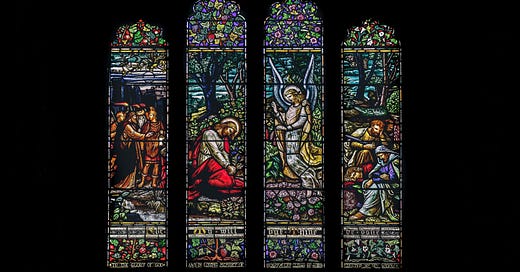Ritually Spontaneous
Reflections on ritualistic prayer, spontaneous prayer, and their complementarity based on today's readings: https://bible.usccb.org/bible/readings/061925.cfm
There are many false dichotomies that exist within Christian circles and some of which can be particularly troublesome for believers. One of these is the false dichotomy between spontaneous and ritualistic prayer.
Many present ritualistic prayer as something impersonal and formulaic, while spontaneous prayer is a more authentic or genuine expression of the heart. In both of these there is some truth as there are many who simply say the words of ritualistic prayer without ever praying and there are many who do lift their hearts to the Lord in spontaneous prayer but fail to find the right words to give expression to this movement.
It is precisely this latter situation Christ hopes to resolve by giving us the words with which we are to pray. He is not suggesting that our prayer should cease to be spontaneous, but He is giving us words that can properly capture the movement of the heart upwards to the Lord.
Without this guidance of the Lord, He warns that we are at risk of using many words without actually saying anything because the movements of our hearts transcend our ability to express ourselves in words. By giving us the words, we are essentially taught not only how to pray but given a way to understand what it means to pray.
In the words of the Our Father we are shown that those spontaneous moments in which we feel drawn to the adoration of the Lord are moments in which we have come face-to-face with the reality that the Will of the Lord is far superior to ours, that He will provide for all of our needs, and that we can cooperate with this will be adopting an attitude of radical forgiveness to others.
In other words, Christ is not suggesting that either spontaneous prayer or ritualistic prayer are superior to one another or that they are even in opposition, but rather that the two can compliment each other. The ritualistic prayers ensure that our spontaneous prayers are given a definitive direction that can truly sanctify these movements of the soul and the spontaneity of it ensures that the prayer is truly driven by the Holy Spirit.
To say it another way, the combination of these two ensures that our prayers become aligned with the true nature of prayer in that they lead us to transcend ourselves in the contemplation of the divine. By trying to capture the movements of our souls that are inspired by the Holy Spirit without the guidance of ritualistic prayer we run a serious risk of worshipping our own ways of expressing ourselves before God rather than worshipping God Himself.
Ritualistic prayer without the genuine and personal dimension of spontaneous prayer is not prayer at all, but spontaneous prayer without being properly directed by ritualistic prayer risks being a form of self-worship. Christ shows us that true prayer becomes true through Christ reconciling these two apparently contradictory forms of prayer into one, just as Christ shows that all truth is a reconciliation of many paradoxical elements of the world being reconciled with Him.
We can see examples of this in prayers like the Rosary or the chaplet of the Divine Mercy, but there is perhaps no clearer and more explicit example of how this takes place than the tradition of the Jesus Prayer in the east. The simple words, often repeated ritualistically, “Lord Jesus Christ, Son of God, have mercy on me, a sinner” do not seem to carry the profundity that anyone who prays this prayer regularly knows they contain.
Yet, those who commit to the ritual of saying this prayer regularly often find that they contain so much of the essential truth of how the Holy Spirit moves our souls and the ritualistic repetition of the prayer very quickly becomes a spontaneous disposition of the soul. One who says this prayer regularly will find these words pouring out of the soul whenever they are in the midst of difficulty.
It is not that this ritualistic prayer is superior to others, or that any one ritualistic prayer is absolutely essential, but it demonstrates in quite easy to understand terms how it is that these two forms of prayer are not an “either-or” but a “both-and”. And not only a both-and, but a both-in, meaning that they both find their proper representation in the person of Christ.
Again, the ritualistic prayer without the spontaneity can risk becoming an entirely extrinsic process without any interior transformation but the spontaneous prayer without solid roots in the tradition of Christian rituals can give an illusion of interior transformation while really only being self-worship.
It is when the two are united that a true interior transformation takes place because the spontaneity ensures that it is not an entirely external practice while the ritual aspect ensures that the object of worship is God and that God is being worshipped in an appropriate way, in a way that God Himself has told us to worship Him.
May we all allow the Lord to guide us in our words, the Spirit to inspire us to lift our souls, and Christ to reconcile us with Him and with all those who love Him.




Lord Jesus Christ, son of God , have mercy on me a sinner … that is going to be my prayer! thank you for sharing that .. there are so many times during my day that I am calling to the Lord for help , support and love .. this will help me !